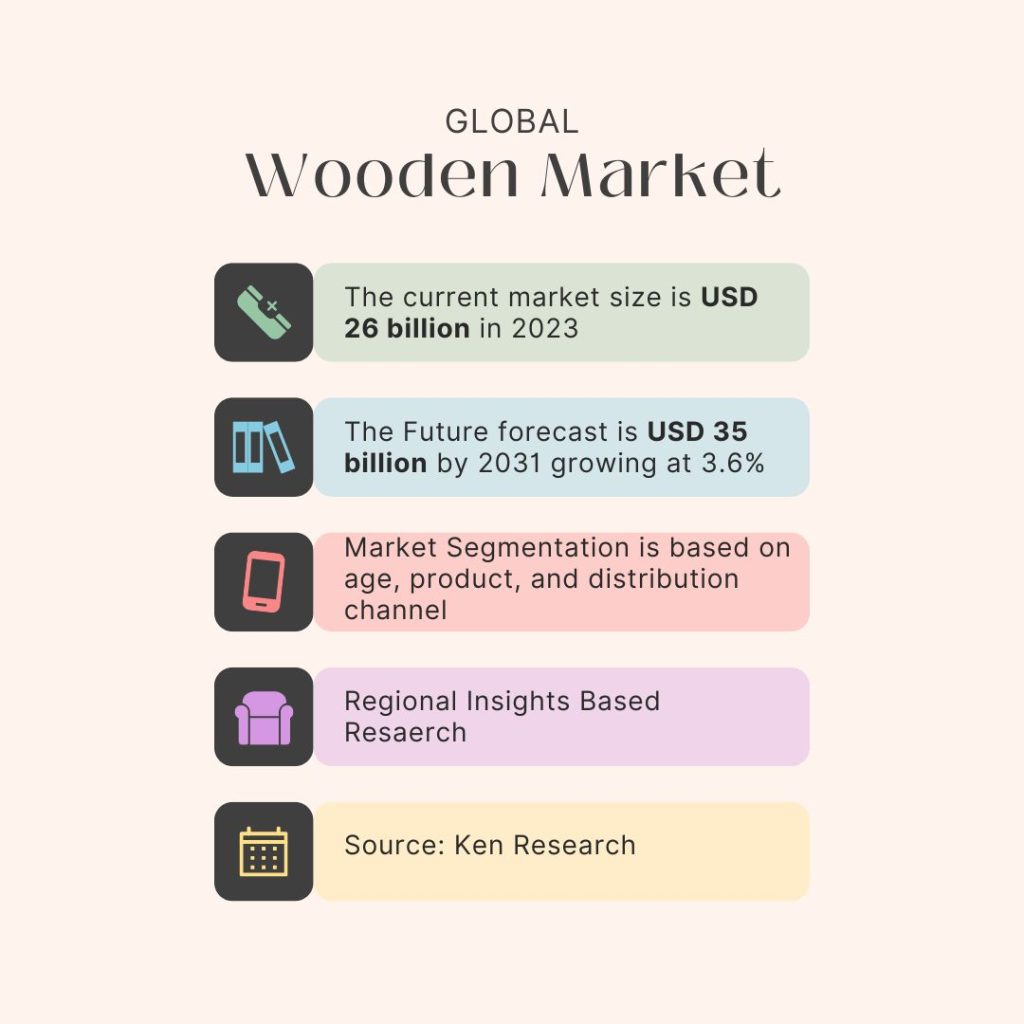The global wooden toys market is substantial growth, driven by various factors that appeal to both parents and children.
The global wooden toys market was valued at USD 26 billion in 2023 and is projected to reach USD 35 billion by 2031, growing at a CAGR of 3.6% during the forecast period from 2023 to 2031. This growth is attributed to the increasing demand for eco-friendly, safe, and educational toys that enhance children’s cognitive and motor skills.
Growth Drivers in the Wooden Toys Industry
- Safety and Non-Toxic Materials: Wooden toys are often made from non-toxic materials, making them a safer choice for children compared to plastic alternatives. This safety aspect is a significant selling point for parents concerned about their children’s health.
- Educational Value: The rise in educational toys that promote learning through play is a major driver. Wooden toys are designed to aid in cognitive development, helping children learn numbers, shapes, and problem-solving skills.
- Sustainability: As consumers become more environmentally conscious, the demand for sustainable products is rising. Wooden toys, often made from recycled materials, align well with this trend, appealing to eco-conscious families.
- Nostalgia and Craftsmanship: There is a growing appreciation for traditional toys that evoke nostalgia. Many parents are seeking high-quality, handcrafted wooden toys that provide unique play experiences while also serving as collectibles.

Market Segmentation in Wooden Toys Sector
The wooden toys sector can be segmented by product type, age group, and distribution channel:
- By Product Type: The market includes educational toys, construction sets, dolls, puzzles, and more. Educational toys are particularly prominent, focusing on learning and development.
- By Age Group: Products cater to various age ranges, from infants to children aged 12 years and older, with specific toys designed for developmental stages.
- By Distribution Channel: The market is divided into online and offline sales, with e-commerce platforms gaining traction due to the convenience they offer consumers.
Read In Depth Market Segmentation for the Toys Industry
Regional Insights of the Market
North America
North America is a leading market for wooden toys, characterized by a strong emphasis on safety standards and educational value. Major players like Melissa & Doug dominate this sector, providing a diverse range of products.
Europe
Europe boasts a rich tradition of craftsmanship in wooden toys, with brands like PlanToys and Hape leading the way. The region’s commitment to sustainability and innovative designs continues to drive market growth.
Asia-Pacific
Emerging markets in Asia-Pacific, particularly China and India, are witnessing rapid growth due to rising disposable incomes and a cultural inclination towards traditional playthings. Local manufacturers are increasingly catering to this demand with region-specific products.
What are the main challenges faced by the wooden toys industry?
The wooden toys industry faces several significant challenges:
- Competition from Plastic Toys: Plastic toys dominate due to lower production costs and mass production capabilities, making them more appealing to price-sensitive consumers.
- Changing Consumer Preferences: The increasing popularity of electronic and digital toys diverts attention from traditional wooden toys, requiring continuous innovation to stay relevant.
- Price Sensitivity: Higher costs associated with wooden toys compared to plastic alternatives can deter budget-conscious consumers, limiting market growth potential.
- Limited Innovation: The industry struggles to introduce new features or technologies compared to electronic toys, which may lead to perceptions of wooden toys as less exciting.
- Market Saturation: In developed markets, saturation can limit expansion opportunities and intensify competition, driving down prices and profit margins.
- Educational Technology: The rise of digital learning tools may reduce demand for traditional wooden educational toys as parents and educators opt for tech-driven solutions.
- Consumer Awareness: Raising awareness about the benefits of wooden toys requires effective marketing, which smaller manufacturers may struggle to implement.
- E-commerce Competition: Intense competition from major e-commerce platforms makes it challenging for smaller wooden toy manufacturers to gain visibility and reach their target audience.
Conclusion
The wooden toys market is on an upward trajectory, driven by safety, educational value, and sustainability. For business decision-makers, understanding these dynamics is essential for capitalizing on growth opportunities. As consumer preferences shift towards eco-friendly and educational products, companies that innovate and adapt to these trends will likely thrive in this competitive landscape.